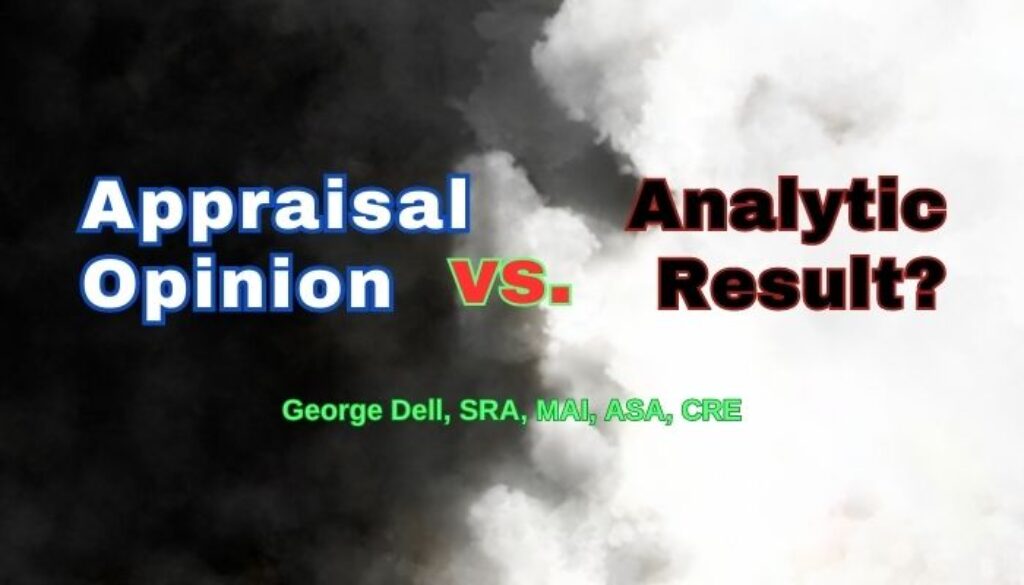USPAP requires that an appraisal is an opinion. EBV yields an analytic result.
Editor’s Note: This is part IIIb of George Dell’s series on How Do I Move to EBV? Links to the earlier posts are here.
USPAP (Uniform Standards of Professional Practice) is promulgated by the Appraisal Foundation, publisher of the irregularly issued rules, which are designed for legal enforcement.
USPAP (in standard practice) provides only a point value, with no indication of uncertainty or risk, although it does require a reconciliation of discrepancies from the three traditional approaches: income, cost, and comparison.
An opinion is defined as a view or judgment formed about something, not necessarily based on fact or knowledge. The traditional view is that an opinion should be supported. “Support” is to bear or hold up; serve as a foundation for.
What is unique about this USPAP organization is the sequence: First you form an opinion, then you find a way to support that opinion. First you ‘pick comps,’ then you ‘analyze the market.’
USPAP was well written some 30 to 50 years ago, with the core substance unchanged since then. The publication has expanded to over 350 pages — mostly explaining the explanations. It provided the best scientific methodology in the last century, given sparse and difficult-to-gather data. (And given the non-existence of even hand calculators!) Picking comps, and a bit of luck, was the way.
In the USPAP book, the only attention to modern regression, adaptive estimation, neural network and AI (artificial intelligence) is in Advisory Opinion 18 (AO18) — which relates only to AVM (Automated Valuation Model) output. As AVMs are built of secret algorithms, AO18 effectively precludes appraiser use.
EBV© (Evidence Based Valuation) is the open Data Science approach to valuation and risk/reliability. EBV also provides for forecasting, revaluation, fundamental value, and enables “socially adjusted” values, such as reparative value. EBV is promulgated by the CAA (Community of Asset Analysts).
EBV is the Data Science approach to questions regarding asset market positioning. Data science recognizes three key advances in technology:
- In most areas, complete market data is available, instantly.
- The focus can be market measurement, not comp comparison.
- Visualization and data-stream delivery enables expert understanding.
EBV results are superior to USPAP in terms of accuracy and precision (trueness and sureness). The factual/logic process also enables replicability and reproducibility of the valuation product. (A side effect is that the subjective “appraisal review” is replaced by an objective audit function.) Bias issues are effectively eliminated, as the process is based on evidence, not judgment/convenience ‘comps.’
Rule #1: You can’t get objective results from subjective data.
Finally, EBV results enable a risk/reliability score noted above. This enables direct electronic “fintech” connection to lender functions such as risk decisions, portfolio management, packaging, and administrative responsibilities.
Public policy and the regulatory function can be considerably simplified. EBV enables counter-cyclical policy and explicit recognition of macroeconomic ‘tail’ risk, significantly improving the public good.
Legislation can easily foster objective facts and logic, not personal opinion. The opportunity is now.

June 14, 2023 @ 8:24 am
This is all great for general market conditions. Does not apply to any one home or appraisal assignment. You cannot predict the future anymore or less then the guy at the horse track. Zillow reports that the color of the front door can bring an average increase of $6,000 on a home sale (charcoal-black). A home with white cabinets/countertops will sell for 10%+ more then not. Lot utility. A slope lot will sell for less then a level lot. Gravel roads, access to utilities, etc. Where do you find this in your EBV? Nothing beats a good appraisal!
July 5, 2023 @ 3:17 pm
Thank you Jerry for speaking the truth!